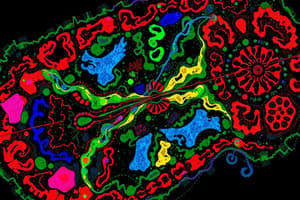Podcast
Questions and Answers
Match the following E3 ligases with their respective characteristics:
Match the following E3 ligases with their respective characteristics:
CHIP = U-box type E3 ligase that interacts with HSP70 and HSP90 through its TPR domains E3 = Facilitates transfer of ubiquitin to the substrate protein, usually a lysine side-chain Stub1 = Encoded by the CHIP gene and mediates substrate protein ubiquitination LRRK = A protein that interacts with CHIP and is targeted for degradation or aggregation
Match the following heat shock proteins with their role in protein folding:
Match the following heat shock proteins with their role in protein folding:
HSP70 = Prevents further aggregation of oligomeric 𝛂–synuclein HSP90 = Involved in later stages of protein folding Hop = Acts as a 'holdase'
Match the following heat shock proteins with their respective interactions:
Match the following heat shock proteins with their respective interactions:
HSP70 = Interacts with CHIP through its EEVD motifs HSP90 = Interacts with CHIP through its TPR domains HSP40 = Encoded by the STUB1 gene and mediates protein folding DNAJ = A protein that interacts with HSP70 and facilitates protein folding
Match the following proteins with their characteristic:
Match the following proteins with their characteristic:
Signup and view all the answers
Match the following protein complexes with their function:
Match the following protein complexes with their function:
Signup and view all the answers
Match the following protein aggregation diseases with the proteins that are ubiquitinated by CHIP:
Match the following protein aggregation diseases with the proteins that are ubiquitinated by CHIP:
Signup and view all the answers
Match the following ubiquitin-proteasome system components with their respective functions:
Match the following ubiquitin-proteasome system components with their respective functions:
Signup and view all the answers
Match the following protein sequences with their binding partner:
Match the following protein sequences with their binding partner:
Signup and view all the answers
Match the following protein degradation mechanisms with their characteristic:
Match the following protein degradation mechanisms with their characteristic:
Signup and view all the answers
Match the following lysine-linked polyubiquitination types with their respective functions:
Match the following lysine-linked polyubiquitination types with their respective functions:
Signup and view all the answers
Match the following protein folding defects with their consequence:
Match the following protein folding defects with their consequence:
Signup and view all the answers
Match the following CHIP targets with their respective diseases:
Match the following CHIP targets with their respective diseases:
Signup and view all the answers
Match the following E3 ligases with their corresponding neurodegenerative diseases:
Match the following E3 ligases with their corresponding neurodegenerative diseases:
Signup and view all the answers
Match the following HSP40 chaperones with their corresponding diseases or disorders:
Match the following HSP40 chaperones with their corresponding diseases or disorders:
Signup and view all the answers
Match the following E3 ligases with their corresponding neurodegenerative diseases:
Match the following E3 ligases with their corresponding neurodegenerative diseases:
Signup and view all the answers
Match the following HSP40 chaperones with their corresponding diseases or disorders:
Match the following HSP40 chaperones with their corresponding diseases or disorders:
Signup and view all the answers
Match the following E3 ligases with their corresponding neurodegenerative diseases:
Match the following E3 ligases with their corresponding neurodegenerative diseases:
Signup and view all the answers
Match the following HSP40 chaperones with their corresponding diseases or disorders:
Match the following HSP40 chaperones with their corresponding diseases or disorders:
Signup and view all the answers




